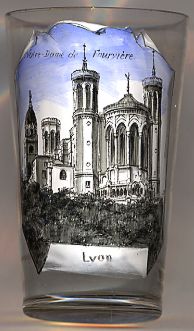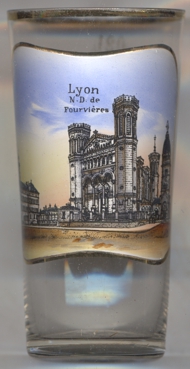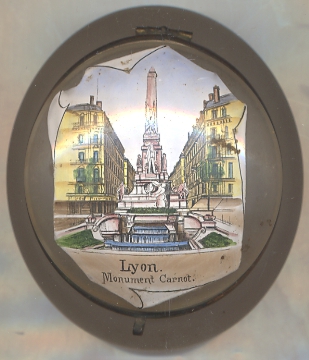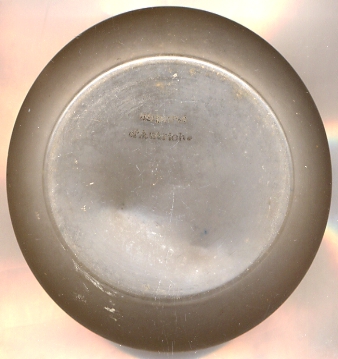

|
| FRANCE | FRANCE |
| région: Auvergne-Rhône-Alpes | |
| département: 69M, Métropole de Lyon |
Lyon is situated at an elevation of 173 m at the conflunce of the rivers Rhône and Saône. Lyon is the capital of the région Auvergne-Rhône-Alpes. Despite being still the préfecture (capital) of the département Rhône (69D), it was separated from the département in 2015 as the métropole de Lyon (69M). Together, the two entities are refered to as the circonscription départementale du Rhône (69). The municipality has a population of about 472,300 (2006). Together with its suburbs and satellite towns, Lyon forms the second-largest metropolitan area in France after that of Paris, with the population of its urban area estimated to be 1,783,400 and that of its metropolitan area 4,415,000 (2007).
Lyon was founded on the Fourvière hill as a Roman colony in 43 BC on the site of a Gaulish hill-fort settlement called Lug[o]dunon,
from the Celtic god Lugus ('Light', cognate with Old Irish Lugh, Modern Irish Lú) and dúnon (hill-fort). Lyon was first named
Lugdunum meaning the "hill of lights" or "the hill of crows". Lug was equated by the Romans to Mercury.
It soon became the capital of Gaul, partly thanks to its convenient location at the convergence of two navigable rivers, and quickly
became the main city of Gaul. Two emperors were born in this city: Claudius and Caracalla. Today, the archbishop of Lyon is still
referred to as "le primat des Gaules" and the city often referred to as the "capitale des Gaules".
The Christians in Lyon were persecuted for their religion under the reigns of the various Roman emperors, most notably Marcus Aurelius and Septimus Severus.
Burgundian refugees from the destruction of Worms by Huns in 437 were resettled at Lugdunum, which was formally the capital of the new Burgundian kingdom by 461.
In 843, by the Treaty of Verdun, Lyon, with the country beyond the Saône, went to Lothar (Lothaire) I, and later became a part of the Kingdom of Arles.
Lyon only came under French control in the fourteenth century.
The fairs in Lyon, the invention of Italian merchants, made it the economic countinghouse of France in the late 15th century.
When international banking moved to Genoa, then Amsterdam, Lyon simply became the banking centre of France. During the Renaissance, the city developed with the silk trade.
Lyon was a scene of mass violence against Huguenots in the St. Bartholomew's Day Massacres in 1572.
During the French Revolution, Lyon rose up against the National Convention and supported the Girondins.
 Thanks to the silk trade, Lyon became an important industrial town during the 19th century.
Lyon was a centre for the occupying German forces and also a stronghold of resistance during World War II, and the city is now home to a resistance museum.
Since 1998 Lyon is listed as a UNESCO World Heritage Site (see list of other UNESCO heritage sites depicted on glasses of this collection).
Thanks to the silk trade, Lyon became an important industrial town during the 19th century.
Lyon was a centre for the occupying German forces and also a stronghold of resistance during World War II, and the city is now home to a resistance museum.
Since 1998 Lyon is listed as a UNESCO World Heritage Site (see list of other UNESCO heritage sites depicted on glasses of this collection).
 The
The  Basilique Notre-Dame de Fourvière [left, no. 2548, and right, no. 4117]
was built with private funds between 1872 and 1896 in a dominating position in the city, as a mark of the triumph of Christian values over the socialists
of the Lyon commune of 1870 like the similarly-inspired Basilique du Sacré-Cœur in Paris. Its design, by Pierre
Bossan, draws from both Romanesque and Byzantine architecture, two non-Gothic models that were unusual choices at the time. Perched on top of the
Fourvière hill, the basilica looms impressively over the city of Lyon, where it can be seen from many vantage points; not unintentionally, the
basilica of Fourvière has become a symbol of the city of Lyon. The basilica has four main towers, and a belltower. It is topped with a gilded
statue of the Virgin Mary. In 1897 it obatined the status of a basilica minor
(see also list of other basilicae minores depicted on glasses of this collection).
Basilique Notre-Dame de Fourvière [left, no. 2548, and right, no. 4117]
was built with private funds between 1872 and 1896 in a dominating position in the city, as a mark of the triumph of Christian values over the socialists
of the Lyon commune of 1870 like the similarly-inspired Basilique du Sacré-Cœur in Paris. Its design, by Pierre
Bossan, draws from both Romanesque and Byzantine architecture, two non-Gothic models that were unusual choices at the time. Perched on top of the
Fourvière hill, the basilica looms impressively over the city of Lyon, where it can be seen from many vantage points; not unintentionally, the
basilica of Fourvière has become a symbol of the city of Lyon. The basilica has four main towers, and a belltower. It is topped with a gilded
statue of the Virgin Mary. In 1897 it obatined the status of a basilica minor
(see also list of other basilicae minores depicted on glasses of this collection).
 The
The  Monument Carnot [left] was a monument in Place de la République, erected in memory of
Sadi Carnot, President of the French Republic from 1887 until his assassination not far from here in 1894.
The monument was designed by architect Charles Naudin and sculptor Henri Gauquié in 1900.
The monument was removed (and largely destroyed) in 1974 during the construction works for the Lyon metro underneath the square.
Monument Carnot [left] was a monument in Place de la République, erected in memory of
Sadi Carnot, President of the French Republic from 1887 until his assassination not far from here in 1894.
The monument was designed by architect Charles Naudin and sculptor Henri Gauquié in 1900.
The monument was removed (and largely destroyed) in 1974 during the construction works for the Lyon metro underneath the square.

[http://en.wikipedia.org/wiki/Lyon; http://en.wikipedia.org/wiki/Notre-Dame_de_Fourvière;
http://fr.wikipedia.org/wiki/Place_de_la_République_(Lyon), http://collections.bm-lyon.fr/BML_01ICO001014ccae04681cdd?&query[]=subject:"monument_aux_mort_&hitStart=10&hitTotal=30,
http://www.persee.fr/web/revues/home/prescript/article/lha_1627-4970_2006_num_12_1_1050]
![[scale]](lineal.jpg)